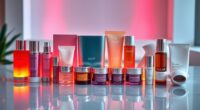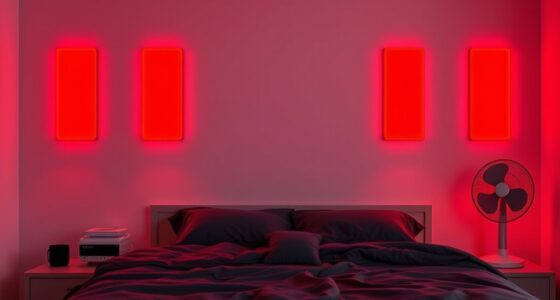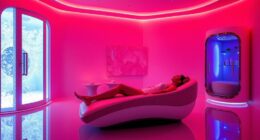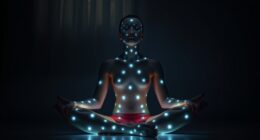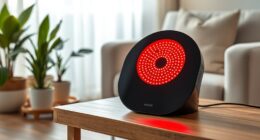You should shield your eyes whenever you’re exposed to bright, direct, or intense LED lights, especially in environments like workspaces or outdoors. High-energy blue light from LEDs can cause eye strain, glare, and potential damage over time. Wearing protective glasses with blue light filters and taking regular breaks can greatly reduce risks. Using lower blue light emission LED lighting also helps protect sensitive eyes. To understand exactly when and how to safeguard your vision, keep exploring these helpful tips.
Key Takeaways
- Shield eyes when exposed to bright or direct LED lighting to prevent glare and potential retinal damage.
- Use protective glasses with UV and blue light filters during extended LED screen or light exposure.
- Limit prolonged exposure, especially for children and teens, to reduce blue light-related eye risks.
- Follow the 20-20-20 rule to minimize eye strain from LED screens and lighting.
- Choose LED lights with lower blue light emissions for safer, everyday use around sensitive eyes.
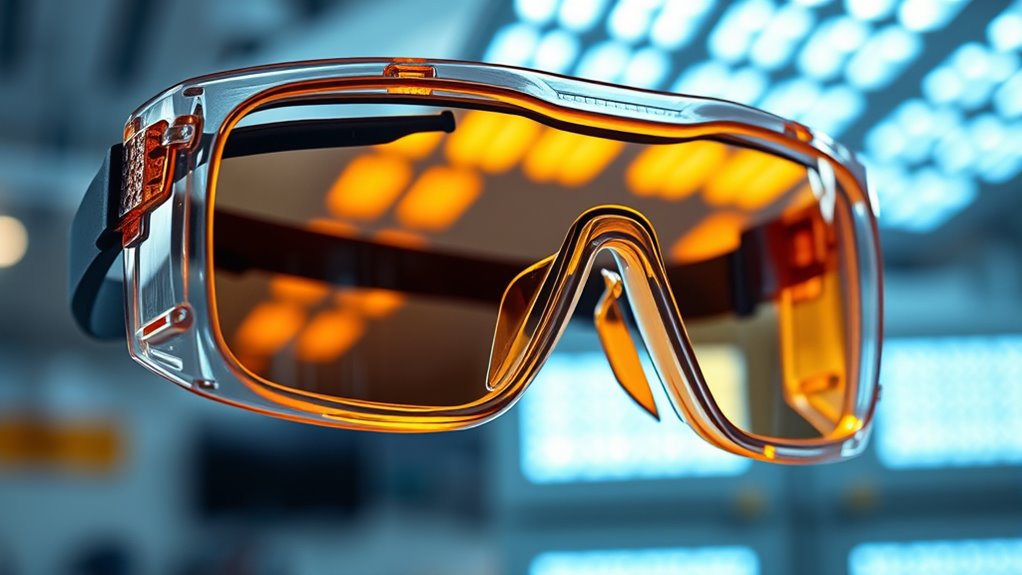
LEDs are popular lighting sources because they are energy-efficient and long-lasting, but they can also pose risks to your eye health if you don’t use them properly. Many people underestimate the potential harm bright, high-intensity LED lights can do to their eyes. Unlike traditional lighting, LEDs emit a significant amount of blue light, which can penetrate deep into your retina and cause damage over time. If you spend a lot of time under LED lighting—whether at work, home, or using electronic devices—you should be aware of when to shield your eyes to prevent discomfort or long-term harm.
LEDs emit blue light that can harm your retina over time; shield your eyes during prolonged exposure.
One of the main concerns with LED exposure is eye strain. When you stare at screens or bright LED lights for extended periods without breaks, you may experience symptoms like dryness, irritation, blurred vision, or headaches. These effects aren’t just temporary; they can lead to more serious issues if left unmanaged. To protect yourself, it’s wise to follow the 20-20-20 rule: every 20 minutes, look at something 20 feet away for at least 20 seconds. This simple habit gives your eyes a much-needed break and reduces strain caused by prolonged exposure.
Another situation where shielding becomes essential is in environments with very bright or direct LED lighting, such as certain workspaces, outdoor lights, or specialized medical and industrial settings. In these cases, the intensity of the light can cause glare, which not only makes it uncomfortable to see but also increases the risk of damage to your eyes. Wearing protective glasses with UV and blue light filters can help minimize this risk. These glasses are especially useful if you work around intense LED sources daily or if you’re exposed to bright LED displays for long hours. They filter out the high-energy blue light and reduce glare, protecting your retina and reducing eye fatigue.
Children and teens are particularly vulnerable to blue light exposure because their eyes are still developing. If your kids are using LED-powered devices or spend a lot of time in environments with LED lighting, it’s important to set limits and encourage breaks. Providing them with blue light filtering glasses can also be a proactive way to shield their eyes, especially during extended screen time. Additionally, choosing LED lighting with lower blue light emissions can help reduce potential risks for sensitive eyes.
Frequently Asked Questions
Can LEDS Cause Long-Term Eye Damage?
LEDs can cause long-term eye damage if you’re exposed to their bright, high-intensity light regularly or directly. Prolonged exposure to intense LED light may lead to eye strain, discomfort, or even retinal damage over time. To protect your eyes, avoid staring directly at bright LEDs, especially for extended periods, and consider wearing protective eyewear or using diffusers, particularly if you work with high-intensity LED lighting daily.
Are All LED Lights Safe for Children’s Eyes?
Not all LED lights are safe for children’s eyes. Some emit high levels of blue light, which can cause eye strain and potential damage over time. You should limit their exposure, especially to bright or intense LEDs, and guarantee children use proper eye protection when necessary. Always choose LED lights labeled as safe for kids, and keep their viewing distance appropriate to reduce risks.
How Do I Choose the Right Eye Protection for LED Exposure?
You should choose eye protection based on the LED’s brightness, wavelength, and exposure duration. Opt for glasses with UV and blue light filters if you’re exposed to intense or prolonged LED use. Always check the product’s safety ratings and consult manufacturer guidelines. If you’re unsure, err on the side of caution by wearing protective eyewear, especially for children, to prevent potential eye strain or damage from high-intensity LEDs.
Do LED Screens Emit Harmful Blue Light?
Yes, LED screens emit blue light, which can cause eye strain and disrupt sleep if exposed to for long periods. You should consider wearing blue light glasses or taking regular breaks to protect your eyes, especially if you spend hours in front of screens daily. Adjusting your device’s brightness and using built-in blue light filters can also help reduce potential harm from prolonged exposure.
Is There a Risk From LED Exposure in Outdoor Lighting?
Yes, exposure to LED outdoor lighting can pose risks, especially if you spend long hours near intense sources. While it might seem harmless or even stylish, those bright, blue-rich lights can cause eye strain, disrupt your sleep, and potentially damage your vision over time. So, don’t dismiss outdoor LEDs as just a modern glow—protect your eyes by limiting direct exposure and wearing appropriate eye gear when needed.
Conclusion
So, next time you’re dazzled by those bright LEDs, remember they’re shining right into your eyes. You might think they’re harmless, but don’t be surprised if your vision starts acting up. It’s ironic, isn’t it? We trust these tiny lights for convenience, yet forget they can also be sneaky eye hazards. Shield up before your eyes pay the price—after all, a little protection now beats a lifetime of regret later.

